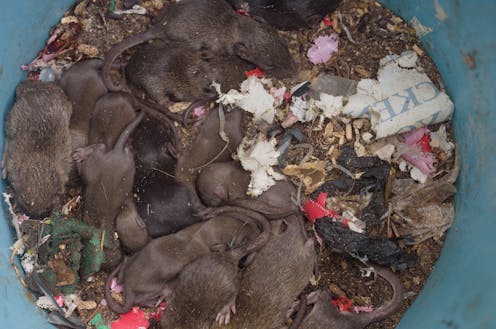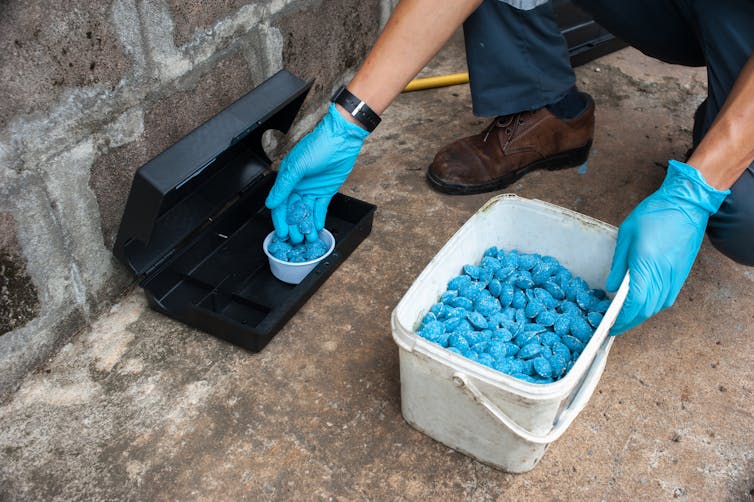
Rats are present in almost every city in the world, building their own rat settlements in parallel with human urban infrastructure.
Cities are ideal habitats for rats because they offer everything a rat needs to survive: food, water and harbourage — a place to live. For brown rats, also known as Norway rats, any patch of soil can quickly become a home, and their omnivorous diets allow them to thrive on kitchen scraps, backyard gardens, fruit trees and even waste in our garbage bins and sewer systems.
Several North American cities are considering the use of new contraceptive products to address rat infestations. This effort is commendable as it shows that cities are exploring alternative approaches to more established techniques that are known to cause harms, such as poisons that kill non-targeted wildlife.
However, the use of birth control raises the question: Could reducing rat reproduction be the solution to our rat worries?

Putting rats on birth control
Rat birth control products, packaged as sugary bait, reduce the number of offspring rats produce. Given that rats can have about five litters a year, with an average of four to eight pups in each litter, addressing reproduction is an attractive approach to reducing rat numbers. However, there are three important limitations to such a strategy.
First, not all rats will eat the bait. This is a classic problem of rat management strategies that rely on poison and kill-trapping. Numerous studies demonstrate that even with intensive baiting and trapping programs, there will often be some rats left behind. Once the campaign ends, the surviving rats can once again reproduce, and populations can rebound in as little as four weeks.

Second, rat birth control does nothing to address the reason for why rats are there in the first place. Access to food, water and harbourage create environments conducive to rats, and also determine the number of rats that can survive in an area. By reducing the number of offspring of rats that eat the bait, it may increase the likelihood of survival of the offspring of other rats that do not eat the bait, as well as rats from any neighbouring areas where the bait was not applied.
For this reason, these types of approaches will likely be most successful in situations where the resources available to rats can be simultaneously reduced or removed and the immigration of new rats can be avoided, such as in indoor settings.
Third, focusing solely on reducing the number of rats may not, paradoxically, reduce the harms that people are experiencing. For example, in under-resourced neighborhoods, rats are symbolic of social injustice and neglect.
Our research has found that most rat complaints to the City of Vancouver are actually complaints about situations involving poor environmental hygiene, where rats are invoked by complainants to urge the city to respond. In neither scenario will reducing or removing rats address the ultimate problem.

Diversified approaches
The bottom line is that just as a variety of tools are needed to build a house, so are a variety of tools and approaches required to successfully deliver a rat control program.
In addition to contraceptives, these tools could include enforcing bylaws that enshrine the right of low-income tenants to a healthy living environment. Municipalities could also implement the use of rat-proof garbage containers or schedule more frequent garbage collection.
Other approaches include programs that prevent the accumulation of tree fruit that could serve as a food source for rats and divert those fruits for human consumption. Even rebate programs that support home improvements could be used — research shows that home improvements for energy efficiency also help keep rodents away.
Ideally, rat control tools are best used in the context of a broader program developed, implemented, maintained, evaluated and improved by a diverse set of specialists. In addition to extermination interventions run by pest control professionals, such a program might include: surveillance to quantify rats and rat-related harms to prioritize management efforts and measure their success; policies to provide municipalities with the legislative authority to prevent and address infestations; new waste management systems; or urban planning to ensure that new developments are more resistant to infestations.
A complex issue like rat management is unlikely to be solved by a single approach. By combining a variety of rat management tools, we not only improve our attempts to address rat-related issues, but also increase the overall health and resiliency of urban environments.
Kaylee Byers is co-lead of the Vancouver Rat Project and collaborates with the Chicago Rat Project.
Chelsea Himsworth is co-lead of the Vancouver Rat Project.
This article was originally published on The Conversation. Read the original article.







